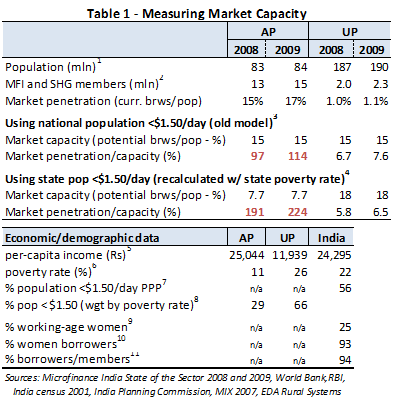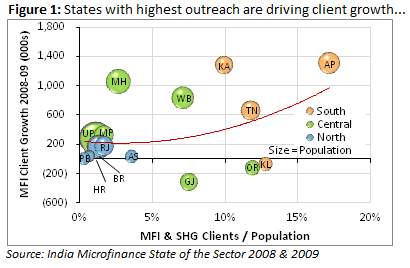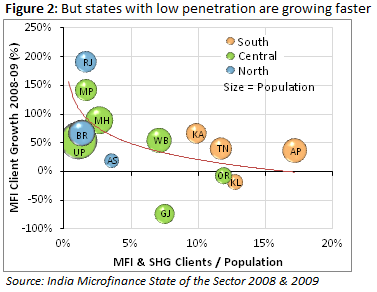Co-authored with Sanjay Sinha; MicrofinanceFocus, 10 Jan 2010
We live in a time of object lessons. The economic crisis continues to buffet many countries, including the US, where the unemployment rate has now breached 10% for only the second time in the last 70 years, taking only 18 months to get there – the largest and steepest increase since World War II. Three years after the first rumblings in the US subprime mortgage market, many banks around the world are still ailing.
The microfinance industry has not been immune either – MFIs in countries as diverse as Nicaragua, Bosnia, and Morocco are under severe stress, while many others have seen their portfolio numbers deteriorate significantly. For the first time in its 11-year history, the industry’s flagship private investment vehicle – Blue Orchard’s Dexia Micro-Credit Fund – reported a net monthly loss.
The sector in India has thus far successfully avoided this fate. While the repayment crisis in southern Karnataka has significantly affected some MFI portfolios in the region, its impact on national microfinance numbers has been minimal. Yet Indian MFIs have been watching and – as Vijay Mahajan and P.N. Vasudevan point out – learning from others’ mistakes.
Indeed, we are gratified to see serious proactive efforts by the leading Indian MFIs to curb overlending and welcome their willingness to discuss and debate this critical topic in the online forum provided by Microfinance Focus. We may disagree on some points, but there is no disagreement on the main issue – that the current path of multiple lending and rapid growth in Indian microfinance is unsustainable. The MFIs have joined forces to establish a self-regulatory regime that seeks to put the industry back on a path of long-term sustainability, and it is this area that we seek to explore. But first, a brief revisit of the current situation.
Is There a Bubble in South India? (an update)
One of us had made a case in an article a few months ago that a microcredit bubble already exists in parts of India, using a model to estimate market capacity and compare that to existing market penetration data. Since this was based largely on the India Microfinance State of the Sector 2008 report, we have updated the model with the recently released 2009 version of the report (Table 1). In addition, we have refined the methodology, notably using more current population data and adjusting for MFI & SHG clients who are not active borrowers (a nod to Tyler Bolender of Lok Capital for the tip). Finally, we’ve added another metric, using rough estimates of potential microfinance clients based on state poverty levels rather than national poverty figures, with both versions shown here – the large gap is evidence of both the regional differences in poverty as well as the absence of more detailed income distribution data. Perhaps a helpful guide in thinking about these numbers is Bangladesh – a country with half the per capita GDP of Andhra Pradesh and a microfinance sector decades older than India’s, yet which in 2008 had a market penetration of 16.4% – nearly a full point lower than the 17.2% most recently reported for the Indian state.
exists in parts of India, using a model to estimate market capacity and compare that to existing market penetration data. Since this was based largely on the India Microfinance State of the Sector 2008 report, we have updated the model with the recently released 2009 version of the report (Table 1). In addition, we have refined the methodology, notably using more current population data and adjusting for MFI & SHG clients who are not active borrowers (a nod to Tyler Bolender of Lok Capital for the tip). Finally, we’ve added another metric, using rough estimates of potential microfinance clients based on state poverty levels rather than national poverty figures, with both versions shown here – the large gap is evidence of both the regional differences in poverty as well as the absence of more detailed income distribution data. Perhaps a helpful guide in thinking about these numbers is Bangladesh – a country with half the per capita GDP of Andhra Pradesh and a microfinance sector decades older than India’s, yet which in 2008 had a market penetration of 16.4% – nearly a full point lower than the 17.2% most recently reported for the Indian state.
Regardless of how capacity is modeled, market penetration has continued its rapid growth, with Indian MFIs adding six million customers in 2009. This is of course good news. The  less good news is that the state that was already the most heavily penetrated in 2008 – Andhra Pradesh – was also the largest contributor to that growth, adding nearly 1.3 million customers (Figure 1). Surprisingly, the second largest contributor is Karnataka, itself a heavily penetrated state, and of course home of the current repayment crisis in Kolar and other southern districts. Indeed, of the top five growth contributors, the three southern states of Andhra Pradesh, Karnataka and Tamil Nadu contributed 54% of new MFI clients in India during 2009. Since these states in 2008 already accounted for nearly half of all microfinance clients in India, the clear conclusion is that growth continues to be driven by states with an already large client base.
less good news is that the state that was already the most heavily penetrated in 2008 – Andhra Pradesh – was also the largest contributor to that growth, adding nearly 1.3 million customers (Figure 1). Surprisingly, the second largest contributor is Karnataka, itself a heavily penetrated state, and of course home of the current repayment crisis in Kolar and other southern districts. Indeed, of the top five growth contributors, the three southern states of Andhra Pradesh, Karnataka and Tamil Nadu contributed 54% of new MFI clients in India during 2009. Since these states in 2008 already accounted for nearly half of all microfinance clients in India, the clear conclusion is that growth continues to be driven by states with an already large client base.
In a country where each state has a population equivalent to medium sized countries, it is perhaps inevitable that this analysis is complicated by regional considerations within states. Thus, while southern Karnataka undergoes a delinquency crisis caused substantially by such a bubble, northern districts of the state continue to be under-served. Similarly, while AP has a very high concentration ratio with bubbles developing in the Guntur-Warangal-Vijaywada region, Medak district (not far from Hyderabad) continues to be under-served. Such large variations within states with high overall penetration numbers suggest that multiple lending is a far greater problem in many local areas than the statewide numbers would suggest. But bubbles aren’t isolated to just these few states. In West Bengal, for example, the region around Kolkata is served by many MFIs with substantial multiple borrowing. Perhaps the most piquant situation is that in Uttar Pradesh (UP), where the Lucknow-Kanpur region has seen substantial MFI activity leading to a local delinquency crisis, despite the fact that the state as a whole is one of the least penetrated of all the larger states in India.
Fortunately, India’s geographic disparity doesn’t just result in MFI concentrations at the local level. The forces that incentivize MFIs to locate in the same localities – especially the lack of communication between different impoverished populations – also help keep local delinquency crises from spreading. The situation in southern Karnataka is a perfect example: although the repayment crisis that originated in the Kolar district spread fairly quickly, it only affected nearby districts, and showed no influence on repayments in the rest of Karnataka or its bordering states, including Andhra Pradesh. A similar pattern was also demonstrated during the crisis in Krishna district of Andhra Pradesh in 2006. However, we should note that throughout this time, India has continued strong economic growth nationally. Whether the same pattern would hold during a country-wide economic downturn remains unclear.
 Given this focus on penetration levels and local delinquency issues, we have not mentioned one important bright point in the 2009 data. India as a whole still has vast regions that are largely unserved by microfinance, but this is beginning to change. While in absolute numbers the heavily penetrated states have contributed the bulk of the growth in 2009, the less-penetrated high-population states are generally growing faster (Figure 2). Indeed, the inversely proportional relationship between existing penetration and growth is undeniable, suggesting that the heavily penetrated states need not be MFIs’ growth engines for much longer, potentially reducing one of the major obstacles to the MFIs’ efforts to curb overlending.
Given this focus on penetration levels and local delinquency issues, we have not mentioned one important bright point in the 2009 data. India as a whole still has vast regions that are largely unserved by microfinance, but this is beginning to change. While in absolute numbers the heavily penetrated states have contributed the bulk of the growth in 2009, the less-penetrated high-population states are generally growing faster (Figure 2). Indeed, the inversely proportional relationship between existing penetration and growth is undeniable, suggesting that the heavily penetrated states need not be MFIs’ growth engines for much longer, potentially reducing one of the major obstacles to the MFIs’ efforts to curb overlending.
Can Self-Regulation Prevent a Bubble?
Deflating bubbles and keeping them from happening is no easy task. However, the current situation presents the leading Indian MFIs with a rare opportunity – benefit from the multiple object lessons provided by recent market crises, and implement preventive measures while their own market continues to thrive. It is difficult to imagine a more auspicious scenario for implementing self-regulatory reforms.
The measures currently being instituted by the industry associations described by Mahajan and Vasudevan – Alpha and MFIN – are sensible and appropriate initial steps. It is gratifying to note that the idea of the credit bureau is recognized as an important tool, but not as a panacea. The MFIs themselves point out the need for a Code of Conduct that would leverage credit bureau information to achieve the most pressing objective – placing boundaries on multiple lending.
Thus, MFIN’s recent announcement to limit MFI lending to no more than three loans and a maximum combined amount of Rs 50,000 ($1,000) per person is a big step in the right direction. This limit, if it is respected by the signatory parties, will no doubt slow growth, most notably in already saturated regions. But with the high growth rates currently enjoyed by top MFIs along with the broadening of their national presence, sacrificing some part of that growth is a small price to pay for insuring against the downside risks of unbridled growth. Indeed, this could be said to be the moment of arrival for Indian microfinance – a maturing market that is implementing appropriate controls to insure long-term sustainability while continuing to expand its outreach to millions of still-unserved poor. Surely now we could put aside our critics’ hats and stop worrying?
Looking Ahead
Unfortunately, old habits die hard. We welcome the efforts of the leading MFIs and hope the overlending limits they will be implemented quickly. However, we are somewhat concerned about the long-term viability of the framework that is being set up. Self-regulation is notoriously difficult and fickle. Current market conditions certainly create incentives for leading MFIs to comply with MFIN’s standards, but situations change quickly and memories fade fast, while the business imperatives to maintain or grow market share never let up.
How will MFIN monitor its members? What enforcement mechanisms will it have to insure adherence, and will these include exposing offenders – a threat that is essential for compliance? And what happens when outside actors, not bound by its rules, begin to chomp at MFIN members’ market shares? It may seem an unreasonable concern, as MFIN currently represents the overwhelming majority of the microfinance market in India, but that may not be the case for very long. Let’s remember that it was the growing market share of new actors in the US mortgage market – Bear Stearns, Lehman Brothers and others – that undermined long-established industry underwriting practices, causing a downward market shift that helped feed the housing bubble.
These are questions not unique to MFIN, but that apply to any self-regulatory body where the nature of regulation comes into direct conflict with near-term business imperatives. As a rule, such structures can easily lose their teeth once clearly visible risks sink back under the surface. Moreover, what makes MFIN’s work particularly difficult is that its present objective – to prevent overlending – is a long-term one. Much like the assets and liabilities of MFIs, the impetus and purpose of self-regulation must also be matched; otherwise enforcement can prove especially difficult.
That is the reason why most financial regulation is after all done by government. Certainly, we don’t want to suggest that MFIN’s efforts should be supplanted by the Reserve Bank of India (RBI) or another government entity, as it would effectively slow the necessary learning and innovation needed to implement such regulation. However, there is a middle ground – RBI, which already oversees the NBFC MFIs that comprise MFIN, could promulgate general objectives (such as limiting overlending) and delegate to MFIN the formulation and implementation of the regulatory policies required to meet them, reserving the right to withdraw this delegation if it deems necessary. By doing so, it would retain the critically important threat of government action, thus giving lasting teeth to the self-regulatory body. At the same time, it would foster more rapid development, better innovation and ultimately more effective regulations than it could develop on its own. Moreover, with such official imprimatur, MFIN’s standards could also become legitimate requirements for all MFIs, not just its members or other NBFCs. We recognize that this would represent a significant departure from the normal regulatory practices of RBI, but microfinance is not a normal financial market, and is very much in need of effective, innovative regulations that at present only the market participants themselves could devise and implement quickly enough to avoid the pitfalls of further overlending.
Finally, as it evolves, MFIN would do well to include input from a consultative body composed of microfinance clients themselves. A study of self-regulation in Australia found that such efforts are usually most successful when they include meaningful participation from customers. MFI clients may be largely illiterate or semi-literate, however they are most directly attuned to their own financial needs, and we believe should be important contributors, particularly on issues pertaining to client protection.
With input from the MFIs, the government, and microfinance clients, MFIN could well become the model for microfinance self-regulation, while assuring long-term sustainability of the microfinance sector in India.
[…] Here’s an excerpt from the original article: […]